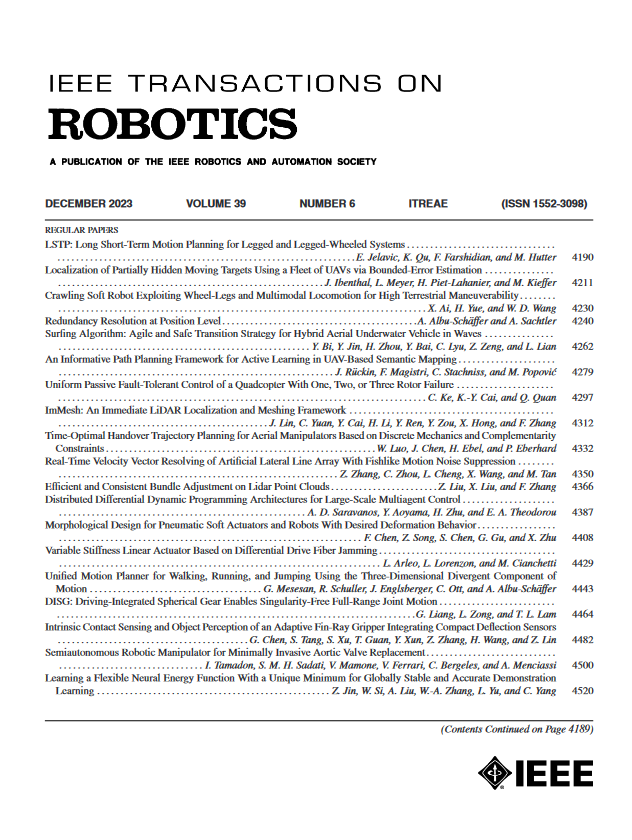柔性人工肌肉优化仿生腿的设计与控制
IF 10.5
1区 计算机科学
Q1 ROBOTICS
引用次数: 0
摘要
高性能仿生腿机器人的发展得益于各种驱动方法的不断进步,例如人造肌肉。这项工作提出了一个由流体弹性体致动器(FEAs)驱动的肌肉骨骼仿生腿,展示了它们作为有腿机器人人造肌肉的潜力。我们的方法集成了三个关键创新:首先,我们利用薄板理论建立了力学模型来优化有限元分析的波纹管壳结构,在保持固有顺应性的同时实现高力输出。其次,我们开发了一种轻量级的嵌入式光电传感系统,可以在不显着增加质量的情况下实现闭环控制。第三,我们在矢状面设计了一个双关节腿,该腿采用了结合单关节和双关节有限元分析的仿生结构。这条腿在各种任务中表现出强大的性能,包括极端的位置运动,承重深蹲,支撑高达2.45倍的体重,垂直跳跃147毫米的离地间隙,以及稳定的行走。值得注意的是,我们的嵌入式传感系统成功地检测了地面接触状态,而无需额外的足部传感器,实现了可靠的步态控制,同时最大限度地减少了复杂性和重量。实验结果验证了优化后的有限元机器人的力学性能和嵌入式传感的可控性,为开发类肌肉驱动的全足机器人奠定了基础。本文章由计算机程序翻译,如有差异,请以英文原文为准。
Design and Control of a Musculoskeletal Bionic Leg With Optimized and Sensorized Soft Artificial Muscles
The development of high-performance bionic legged robots can benefit from the continued advancements in various actuation methods, such as artificial muscles. This work presents a musculoskeletal bionic leg driven by fluidic elastomer actuators (FEAs), showcasing their potential as artificial muscles for legged robots. Our approach integrates three key innovations: First, we established a mechanics model using thin plate theory to optimize the bellows shell structure of the FEAs, achieving high force output while maintaining inherent compliance. Second, we developed a lightweight embedded optoelectronic sensing system that enables closed-loop control without significantly increasing mass. Third, we designed a two-joint leg in the sagittal plane that utilizes a bionic configuration incorporating both monoarticular and biarticular FEAs. The leg demonstrated robust performance across various tasks including extreme positional movements, load-bearing squats supporting up to 2.45 times its body weight, vertical jumping with 147 mm ground clearance, and stable walking. Notably, our embedded sensing system successfully detected ground contact states without additional foot sensors, enabling reliable gait control while minimizing complexity and weight. The experimental results validate both the mechanical capabilities of the optimized FEAs and their controllability through embedded sensing, laying a foundation for developing full legged robots with muscle-like actuation.
求助全文
通过发布文献求助,成功后即可免费获取论文全文。
去求助
来源期刊

IEEE Transactions on Robotics
工程技术-机器人学
CiteScore
14.90
自引率
5.10%
发文量
259
审稿时长
6.0 months
期刊介绍:
The IEEE Transactions on Robotics (T-RO) is dedicated to publishing fundamental papers covering all facets of robotics, drawing on interdisciplinary approaches from computer science, control systems, electrical engineering, mathematics, mechanical engineering, and beyond. From industrial applications to service and personal assistants, surgical operations to space, underwater, and remote exploration, robots and intelligent machines play pivotal roles across various domains, including entertainment, safety, search and rescue, military applications, agriculture, and intelligent vehicles.
Special emphasis is placed on intelligent machines and systems designed for unstructured environments, where a significant portion of the environment remains unknown and beyond direct sensing or control.
 求助内容:
求助内容: 应助结果提醒方式:
应助结果提醒方式:


